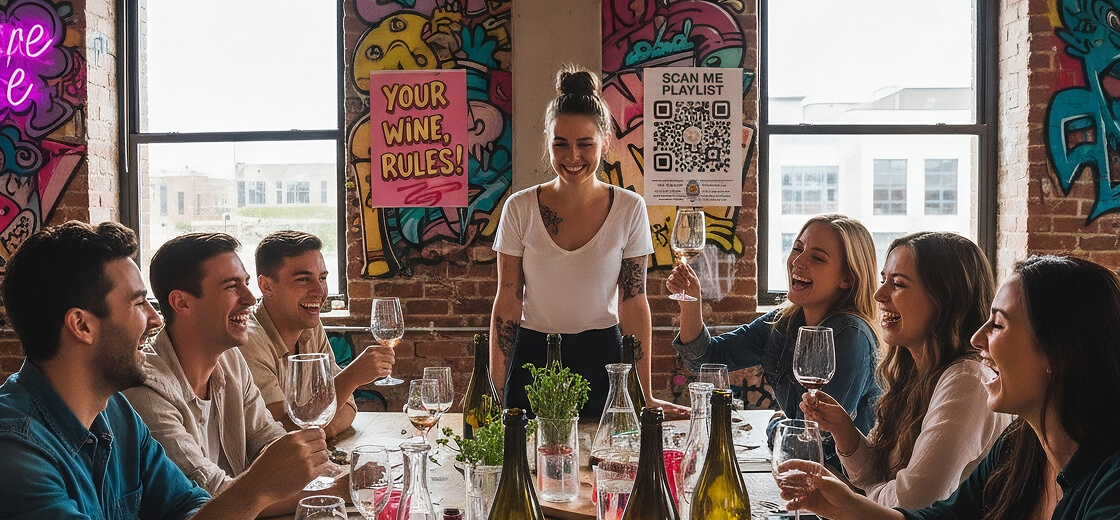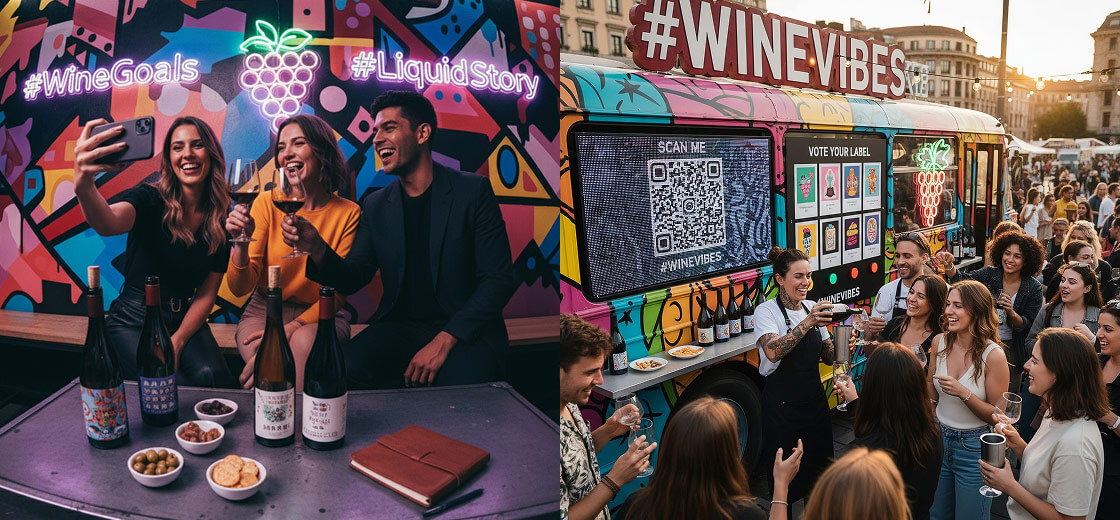Wine advertising – with a twist
Wine has a reputation for being old-fashioned. Old vines, old cellars, old words. ‘Powerful body,’ ‘expressive finish,’ ‘rich bouquet’ – somehow these phrases feel more like a formal evening than a popping cork. No wonder many young people have long seen wine as stiff, elitist, and frankly a bit boring. But times are changing. Wine shows more faces than ever – and its language is being completely rewritten.
Less "bouquet", more "boom"!
Expectations and motivations around wine have changed. Young drinkers want to feel wine, not memorize its technical details. They’re looking for moments of enjoyment – not tests on grape varieties or vintages. But opportunities are often limited. The goal is therefore clear: create more chances for young wine consumers to taste wine and engage with the culture of enjoyment – using simple, clear language, inviting presentations, and straightforward offers. Wine needs to be tangible. Less fear of the unknown, more courage to try.A new generation of winemakers is proving that wine communication can sound different today – more direct, honest, and approachable than ever.

From technical jargon to authenticity
What used to be considered expertise now often comes across as aloofness. Dropping terms like ‘malolactic fermentation’ or ‘primary aromas’ might show knowledge – but they hardly touch anyone’s heart. Young wine drinkers want to know what they’re drinking, without being lectured. They care about origin, attitude, and personality – and they want to feel the humans behind the wine.Winemakers who sweat in the vineyard, laugh in the cellar, or grin at mishaps on social media are closer to this generation. Wine isn’t about explaining anymore; it’s about bringing it to life. Simply describing how a wine smells like summer rain can be more convincing than any technical sheet.

Wine that finally speaks like us
To attract young people, wine has to come to them – not the other way around. At concerts, food festivals, or art exhibitions, wine becomes exciting when it’s experienced, not explained. Low-threshold access is key. And thanks to TikTok, Instagram & Co., wine now has a new language: light, spontaneous, and full of joie de vivre.TikTok, Insta & Co – where wine comes to life
Today, anyone who wants to talk about wine doesn’t need a poster – they need a profile. Every day, new wine stories appear on Instagram, TikTok, or YouTube: humorous, spontaneous, authentic. Young winemakers share their daily lives between the vines and their smartphones, post mini-tutorials on grape varieties, taste live, dance, explain, laugh.Accounts like @weingutknodttrossen and @asktoni.de as well as our columnist @miltonsidneycurtis are shaping this new wine language. They mix entertainment with knowledge and show that wine isn’t elitist – it can be emotional, easygoing, and thoroughly fun. And it’s not just about enjoyment: sustainability, biodiversity, and women in wine are part of the story too. Wine is no longer a status symbol, but a topic that moves, inspires, and connects people.
Funky labels and clear messages
Wine first hits the eye – and that has always been true. But while classic labels rely on gold embossing, coats of arms, and cursive writing, young wineries are reinventing the bottle front. Instead of a castle view: a comic character. Instead of cursive grape varieties: bold typography, pop colors, and statements that catch the eye.
Today, a label is more than just a piece of paper – it’s a stage, an invitation, and an attitude all at once. Some feature little poems or QR codes linking to videos or playlists. Others let their community help choose the next label color. The classic wine label is becoming a medium for a new culture of communication. Brands like Young Poets, Emil Bauer, Niepoort’s Fabelhaft, Gut Oggau, and Wildner – Der Wein mit der Katze (The wine with the cat) show that creativity on the label isn’t superficial – it’s about personality. Today, quality means character. Courage. Enjoying being different.
What ideas and events do winemakers need to create so that young people can simply try, experience, and enjoy wine? You’ll find answers to this and other fascinating questions in our wine talk with the young german winemaker Stefan Wildner.
To the WineChat
To the WineChat
Retelling wine – and experiencing it anew
The new generation of wine lovers doesn’t want decorum, they want dialogue. Not technical lectures, but emotion. And the industry is responding – with open words, fresh designs, and stories that make you want to join in. Wine communication with a difference means less pathos, more personality. Less textbook, more life. And perhaps that’s exactly why wine is exciting again – for those who already love it and for those just discovering it.
Seite bewerten
Welcome to wine.vino.wein – the wine lover’s magazine
In our magazine you will find editorial articles and information about wine. As we are committed to the responsible use of alcoholic beverages, the content is aimed exclusively at adults and you must be at least 18 years old to visit wine.vino.wein.